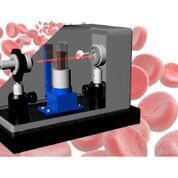ALL MALARIA PARASITES DETECTED BY A POD SYSTEM USING MAGNETIC FIELD OF PARASITE
prof .DRRAM,HIV /AIDS,HEPATITIS ,SEX DISEASES & WEAKNESS expert,New Delhi,India, profdrram@gmail.com,+917838059592,+919832025033,ON WHATSAPP
According to the World Health Organization, over 216 million people were infected with malaria in 2016, and 445,000 individuals died from the disease. The key to solving this health crisis is early-stage diagnosis when malaria therapeutics are most effective. A new prototype for a portable instrument capable of early-stage malaria detection has been developed by a team of researchers at the USC Viterbi School of Engineering.
 There are two standard ways of diagnosing malaria—yet both have limitations. The first involves taking a blood sample from a person and looking at it underneath a microscope for red blood cells that have been infected with the malaria parasite. This involves counting cells—which is manually intensive and dependent on the technician reading the blood smears. The second approach, known as the rapid diagnostic test (RDT), works in about 15 minutes. However, without refrigeration, RDTs can spoil like milk or eggs.
There are two standard ways of diagnosing malaria—yet both have limitations. The first involves taking a blood sample from a person and looking at it underneath a microscope for red blood cells that have been infected with the malaria parasite. This involves counting cells—which is manually intensive and dependent on the technician reading the blood smears. The second approach, known as the rapid diagnostic test (RDT), works in about 15 minutes. However, without refrigeration, RDTs can spoil like milk or eggs.
The Portable optical diagnostics system (PODS) prototype developed by USC Viterbi engineers Andrea Armani, Samantha McBirney, Dongyu Chen, and Alexis Scholtz, detects a byproduct generated by all species of the malaria parasite. As such, it is a rapid screening for all malaria strains.
The PODS instrument was designed to solve the challenges limiting current systems. To minimize size, weight, and power requirements without sacrificing performance, every aspect was considered. The current prototype weighs fewer than 10 pounds, is 12 by 10 inches (the size of a large shoebox) and can be powered by a battery for eight hours. In addition, PODS was designed to require minimal sample processing and handling, as well as eliminate the need for secondary chemicals with strict storage requirements. This makes the device particularly suited to low-resource environments.The end result: The current prototype developed by USC researchers can analyze an unprocessed, whole blood sample in 10-15 minutes. With only 500 μL of blood (five to seven drops), it can achieve sensitivity levels needed for an early-stage diagnosis.
THE PODS SYSTEM: THE LASER BEAM PASSES THROUGH THE BLOOD SAMPLE AND HITS THE DETECTOR ON THE OTHER SIDE. TWO MEASUREMENTS ARE TAKEN: ONE WITH THE MAGNET NEXT TO THE SAMPLE AND ONE WITHOUT THE MAGNET. IF THERE IS ANY HEMOZOIN IN THE BLOOD, IT WILL BE PULLED TO THE SIDE OF THE SAMPLE HOLDER BY THE MAGNET, CHANGING THE AMOUNT OF LIGHT THAT CAN MAKE IT TO THE DETECTOR. IMAGE CREDIT/SAMANTHA MCBIRNEY
How the Device Works
Malaria-infected mosquitoes infect human hosts with the parasite. Its primary nutrient source is hemoglobin, a component of red blood cells. As the parasite digests hemoglobin, it creates what is known as heme as a byproduct.“While heme is highly toxic to both the parasite and its host, the parasite has figured out a ‘loophole’ around this by aggregating heme into an insoluble nanocrystal known as hemozoin. Unlike all other naturally-occurring materials in the blood, hemozoin is magnetic,” says lead author, co-inventor, and recent biomedical engineering Ph.D. graduate, Samantha McBirney.
“PODS operates on a very simple design concept. If there is hemozoin, then there must be malaria,” said Armani, “The challenging part was distinguishing the tiny hemozoin nanoparticles from everything else in the whole blood sample.”
- Kidney stones universally present hazard in north india,dillution by water prevent it
- Steroid and placebo effect equally for mild persisting asthma with low sputum eosinophils
- Government wants to fix public healthcare staff shortages with ayush docs: will it work?
- Plea in hc for payment of salaries of edmc, north mcd teachers and doctors
- 7 indian pharma companies named in us lawsuit over inflating generic drug prices
- Woman in up dies after explosion in her mouth during treatment,what is diagnosis?
- Woman in up dies after explosion in her mouth during treatment,what is diagnosis?
- Woman in up dies after explosion in her mouth during treatment,what is diagnosis?
- Air pollution ! mothers organising rally in london,anaesthetist choosing gas,will india follow?
- Cardiac arrest is always not sudden as understood -a study

 Comments (
Comments ( Category (
Category ( Views (
Views (